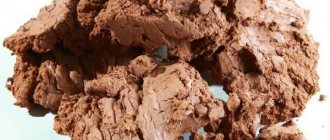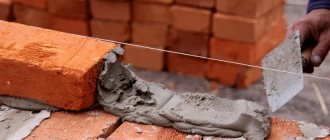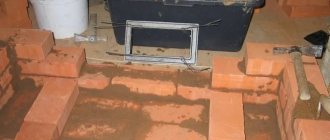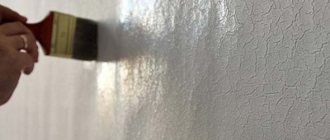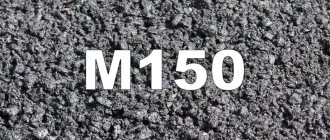A cinder block is a building product that is manufactured industrially or by handicraft. The production uses the method of vibration pressing of concrete in special forms.
Cinder block is one of the most popular building materials due to its low cost composition and low manufacturing cost. What makes the product popular is the abundance of materials in the working solution—what the cinder block is made of.
Materials for making cinder block
The standard solution for the production of wall stone includes mixtures, materials and substances such as slag, coal ash, combustion waste from blast furnaces and open-hearth furnaces. But in practice, the presence of just such components is not necessary - most often the filler that is most common in the region is used. For example: perlite, gravel, crushed stone, limestone, expanded clay, sawdust, sand and gravel mixture.
If you maintain the correct proportions when adding non-traditional building materials, you can not only increase the strength of the building stone, but also reduce its cost. Reinforced cinder block is produced in accordance with the requirements of GOST 6133-99.
Only a few points are mandatory for compliance with GOST, namely:
- Compliance with the color of the mixture according to the sample.
- Compliance with the rectangular shape according to GOST.
- The amount of voids or fullness.
- The thickness of the walls and partitions of hollow wall cinder blocks is not less than 20 mm.
- The symbol of the product must contain the abbreviated designation of the stone - K, the area of use and construction purpose (S - masonry walls or P - partitions, L - front block or R - row block), type of block for laying (PR - row block, UG - corner , PZ - dressing block), with voids (PS - hollow product), length in cm, frost resistance grade, strength grade, average density coefficient and GOST.
An example of designation of a product with a length of 410 mm, strength grade 50, frost resistance grade F75, average density 1800 kg/m: KRL-PZ-PS-41-50-F75-1800 GOST 6133-99.
The composition of the mortar for the production of cinder blocks according to GOST 6665-91 “Concrete wall stones. Technical specifications":
- Cement M-400 class D 20.
- Purified and sifted quartz sand for the mixture.
- Screening is a material that is obtained by crushing rocks, gravel or crushed stone.
- Water.
The mixture for preparing blocks is prepared in the following proportion: sand, cement and slag in a ratio of 3:1:5. Adding water is 0.5% of the amount of cement. If the cinder block is pressed without the use of sand, then the following proportions must be observed: 1:9 with the same water consumption.
It is recommended to dry the product until the product is completely hardened for 20–30 days at high air humidity and a temperature of 20 °C (requirements of GOST 6133-99). To speed up the hardening of concrete, plasticizers can be added to the solution.
The blocks can be placed on a pallet 4 days after complete drying. In winter, hollow wall stone should be laid with the voids facing down to avoid cracks. Table of consumption of building materials per unit of building block (recommended proportions)
| Building material | Quantity, kg. | Price per piece, rub. | Total cost, rub. |
| Water, l | |||
| Cement M400 D20, kg | |||
| Sand Microdistrict 2.5, kg | |||
| Elimination, kg | |||
| Total: |
Note to the table:
- Hollow wall block, size 188x190x390 mm.
- The total volume of one wall stone is 0.0139 m.
- The volume of solution per block is 0.01 m.
- The number of blocks in 1 m is 72 pcs.
- Strength grade: M75.
- The cost of materials depends on your region and may vary.
Cinder block refers to wall stones, which are made from materials mixed in different proportions according to the standard regulated by OKP 57 4130, which gives an idea of the use of materials for the production of wall stone groups that differ in the content of substances.
The dimensions of cinder blocks can vary within +/- 2–10%, since this parameter is not strictly defined by GOST 6133-99 (deviations in size are allowed), but the operational, physical and technical characteristics of the wall block must comply with the standards. Pigmentation of a cinder block is also regulated by GOST 13015.0-83 and GOST 6133-99, which state that the color of the front surface of a cinder block must correspond to duly approved samples.
[my_custom_ad_shortcode1]
Calculation of consumption per cubic meter
When calculating the required amount of material, you need to build on the type of masonry.
The most common and economically advantageous is masonry of 0.5 - 1 block. In this case, the thickness of the layer will be 1-2 cm. It is no longer recommended to do it, as this will negatively affect the strength of the object being built.
Recommendations for performing calculations:
- Decide on the amount of material needed.
- Calculate the cost of masonry taking into account the thickness of the layer.
- You should not buy material for future use. Store-bought mixtures or consumables for making it yourself are always available for sale.
If you cannot cope with the calculations yourself, you need to contact specialists.
Here is an example of how much mortar needs to be prepared per cube of cinder block masonry: with a wall thickness of 40 to 50 cm and when performing work at a temperature of +5...+25 degrees, the minimum consumption of the mortar is 30-40 kg per 1 m3.
Composition by type of filler
Cinder block is produced in the form of a solid or hollow parallelepiped with right angles. The following compositions of building stone are distinguished depending on the filler:
- SCC - with the addition of cement as a binder.
- SKI - with the addition of lime as a binder.
- SKSH - with the addition of slags of various origins.
- SKG - with the addition of gypsum or alabaster.
The cinder block is divided by size into whole (number 1 in the marking), longitudinal half (number 2) and partition wall block (number 3).
For example, SKTs-1 (cement wall stone), SKI-3 (lime wall stone), SKSH-1 (slag wall stone), SKG-2 (gypsum wall stone), etc. Table
| Block type | Options | Compressive strength grade | Size, cm | Cinder block weight (kg), solution density 800–2200 kg/m | Volume of concrete, m |
| SKTS-1; SKI-1; SKSH-1 | Solid ordinary block | M25, M35, M50 | 39×19×18,8 | ||
| SKTS-2; SKI-2; SKSH-2 | Longitudinal half | M75, M100, M125, M150, M200 | 39×9×18,8 | ||
| SKTS-3; SKI-3; SKSH-3 | Cloisonne block | M25, M35, M50 | 59×9×18,8 | ||
| SKG-1 | Solid ordinary block | M25, M35, M50 | 39×19×18,8 | ||
| SKG-1A | Solid ordinary block | M25, M35, M50 | 41×21,5×19 | ||
| SKG-2 | Longitudinal half | M75 | 39×9×18,8 |
- Depending on the filler introduced, a solid block has an average weight of 25-28 kg, a hollow block - 18-23 kg, and a half-slag block - 10-13 kg. The thermal conductivity coefficient of a cinder block also depends on the composition of the solution and occupies the range of 0.27–0.65 W/m*K.
- The compressive density is allowed in the range of 750–1455 kg/m. When the density changes, the thermal conductivity and strength of the wall stone changes. Also, the density characteristics, weight of the blocks and thermal conductivity depend on the composition of the mixture and the number of voids in the product - they can be oval, round, rectangular or square.
- The percentage of voids to filler is 28–40%.
- The texture of the blocks is divided into smooth (without visible surface defects), polished (1 grinding cycle), corrugated (repeating irregularities) and chipped (the surface is leveled by chipping off the protrusions). For different slag concrete fillers, their own, most optimal, stone texture is determined.
Table of composition of fillers for wall blocks
| Type of filler | Cement kg/m | Brand/class of concrete | Density kg/m |
| Blast furnace, coal, wood, open hearth ash and sand | |||
| Fly and waste ash | |||
| All types of ash and sawdust (shavings) | |||
| All types of ash and expanded clay | |||
| Quartz sand and expanded clay | |||
| Quartz sand and sawdust (shavings) | |||
| Quartz sand and polystyrene foam | |||
| All types of ash polystyrene foam | |||
| Quartz sand and crushed brick | |||
| Slag and all types of ash | |||
| Arbolit | |||
| Soil concrete |
What can't construction be done without? That's right, without the material with which the structure is built. Why is it so important to choose exactly the right building material?
The stability of the supporting structure depends on this factor. But choice alone is not enough here; you need to understand the types and brands of building materials in order to ultimately buy reliable blocks or bricks that meet the standards and are made in accordance with the proportions.
Cinder block is a practical and inexpensive building material that is widely used. This is an ideal option for non-residential construction. For the most part, garages and sheds and other agricultural facilities are built from cinder blocks. Some craftsmen wonder whether it is possible to make a cinder block at home and what is the proportion of the solution for the cinder block.
Is it appropriate to make blocks at home if the market is already full of all kinds of offers?
Of course, during the construction process it may turn out that you are missing a couple of dozen blocks, and the ability to independently ebb will come in handy here more than ever. Naturally, buying a large volume of material will cost a little less, because in order to make a cinder block, you will need special equipment.
In private construction, the practice of making cinder blocks with one’s own hands is used to build a garage or shed. Construction waste left after work creates compensation for expenses. If you try, then you can not recycle it, but use it for personal purposes.
Therefore, the question of casting the blocks of the house and calculating the proportion of the solution for the cinder block has a right to exist. It’s better to have a dialogue about this with craftsmen who specialize in this and know a lot about making cinder blocks at home. The expert will tell you what the finished product consists of, what the proportions of the solution for the cinder block are and where it is used. We will try to answer some of the frequently asked questions in our article.
[my_custom_ad_shortcode2]
Thermally insulated pie
According to SNiP 02/23/2003, the thickness of the wall of a cinder concrete block should be 15-20 cm. With this width, a comfortable microclimate for living is maintained.
For the outside
What does a wall pie with insulation look like correctly?:
- Wall.
- Adhesive adhesive composition on which the insulation is attached (if it is suitable for thermal insulation).
- Insulation. Its thickness depends on the characteristics of the selected material. For northern regions, 10 cm is enough, for southern regions 5-7 cm.
- Reinforced mesh.
- Waterproofing. A special waterproof film or membrane is chosen for it.
- Facing material. For external work, choose a weather-resistant material, for example, siding, clinker brick, or cover the house with decorative plaster for painting.
For internal
Internal insulation of cinder block is used simultaneously with external insulation. As a last resort, when it is not possible to install thermal insulation on the outside of the building.
Pie structure:
- Wall.
- Antifungal coating. Prevents the appearance of microorganisms.
- Insulation. As a rule, it is laid in 1 layer 5 cm thick.
- Vapor barrier. Thermal insulation from the inside is most often done for end walls and in the bathroom/steam room. The exhaust air must not condense on the wall. A layer of vapor barrier helps bring it back, keeping the house warm.
- Facing material. Most often they choose dry fastening of plywood or plasterboard, which are then decorated as desired.
Important! If you choose insulation that is attached in layers, you will need to install profiles to hold it in place. The layers themselves are fixed with disc-shaped dowels to secure the connection and maintain the ventilation gap.
Composition and sizes of cinder blocks
The dimensions of cinder blocks are determined by the standard. For this material they are 380x180x187 mm (length/width/height). But it is not necessary to adhere to these standards, because in individual construction there is a need to combine materials. The parameters of cinder blocks are not strict values, therefore they can be changed taking into account the individual characteristics of the building and the direction of construction.
Please note that cinder blocks with standard parameters are difficult to use in practice. The reason for this is the considerable specific gravity of the material, varying from 18 to 26.5 kg. Because of this, the progress of building construction is slowing down.
[my_custom_ad_shortcode3]
Scope of application
Cinder block is not intended for the construction of buildings higher than one floor. This material is used for the following types of buildings:
- garages;
- one-story residential buildings;
- sheds for keeping livestock;
- temporary buildings;
- country houses;
- workshops.
When building higher residential premises, for example, frame houses, this material is used as insulation.
It is not recommended to build multi-story buildings from cinder blocks due to the low load-bearing capacity of the material.
Buildings built from this material have advantages and disadvantages. Benefits include:
- low probability of fires;
- strength;
- efficiency;
- resistance to temperature changes;
- high speed and ease of construction;
- long service life;
- high rates of sound insulation;
- resistance to biological destruction.
Along with its advantages, the building material has a number of disadvantages. These include:
- toxicity;
- hygroscopicity, that is, high ability to absorb moisture;
- low thermal insulation, which is why buildings need additional insulation;
- difficulties when laying pipes in a cinder block building;
- problems when pulling cables in a building;
- unaesthetic appearance.
The characteristics listed above force builders to use more expensive building materials to insulate the building, insulate the walls from moisture and finish the walls on the outside.
The basis of the building material, slag, sometimes contains acids and sulfur, which are unfavorable to human health, so it is recommended to weather this material in the open air for a year.
Component proportions
Before determining in what proportion to mix the solution for the cinder block, you need to find out what components it consists of:
- Cement grade M350 and more. Otherwise, the solution will not be strong enough, and the blocks will not withstand the pressure and will break under the pressure.
- Medium- or fine-grained slag.
- Sand or screenings used to increase the strength of finished blocks.
- Plasticizers (UPD) or modifying additives that improve some properties of concrete and accelerate cementation processes.
- Industrial water added to the dry mixture according to the proportion of the cinder block solution prescribed in the instructions.
The solution, in a simplified form consisting of cement, slag and water, is mixed in a ratio of 1: 7: 0.7. You can familiarize yourself with more precise proportions by studying the table below. Please note that the preparation recipe and proportions of the solution for cinder block differ depending on the component composition, size of slag grains and silicates.
[my_custom_ad_shortcode4]
Molds for cinder blocks
To produce cinder blocks under production conditions, special forms are used, consisting of metal, vibrators, and special presses that pre-press the concrete solution. Important! Remember that in the process of casting blocks from slag materials, it is necessary to maintain the proportions of the solution for the cinder block.
[my_custom_ad_shortcode5]
Why is it important to follow technology?
To obtain high-quality material, it is very important to strictly observe the proportions of all components of the mixture. There are recipes that have been tested over the years. You should measure the amount of water very carefully . Its quantity is of particular importance, since it is precisely because of the incorrectly calculated proportion of water that the output most often results in low-quality building material.
The mixture should not be liquid so that the blocks form well and do not spread. Only then will they harden in the shortest possible period of time.
The quality of the material , and therefore the durability, strength and reliability of walls built from cinder blocks, and the absence of defects and cracks in building structures, depend on well-calculated proportions.
What are cinder blocks made of?
None
In 99% of cases, timber is used; being the cheapest (or rather free) of materials, it has always attracted attention. Crushed bricks, wood sawdust, which is indispensable in insulation, and metallurgical industry waste remaining after burning coal are often used as fillers.
But the highest quality material is considered to be one made from expanded clay, according to the proportion of the solution for laying the cinder block. This is a filler that occupies more than 50% of the volume of the cinder block, the rest is distributed among additional substances:
- sand;
- cements;
- water;
- other components.
It also happens that the material needs to be given additional strength. Then a plasticizer is added to the cinder block solution as a binder, which gives the material stability. Important!
When planning to make cinder blocks at home, please note that the plasticizer for cinder blocks is different from others, for example, those that are added to the composition of liquid wallpaper, etc.
[my_custom_ad_shortcode1]
Technological process of casting cinder blocks
Good and reliable cinder blocks are obtained by using a solution of medium fluidity. This factor is important to consider during the preputial distribution of components and their mixing. Often this is a typical concrete solution, mixed in a concrete mixer or manually with the addition of plasticizers and production waste.
After preparing the mixture, according to the proportion of the solution for making cinder blocks, it is poured into molds and wait until the blocks harden. This is a home option for casting building blocks from slag. In production conditions, everything happens differently. Specialized equipment is used here, and special techniques for mixing components are used.
Knowing how to determine the proportions for preparing a solution for a cinder block, you can make the building material yourself. How to do it: with your own hands or purchase factory units, it’s up to you to decide. In any case, following the selection rules and expert advice, typical mistakes when purchasing building materials can be easily avoided. When giving preference to purchased cinder blocks, choose materials from proven rating companies.
Knowledge of the proportions and standards for the production of concrete solutions will help to produce a product that meets technical standards and is suitable for the construction of residential buildings.
For the construction of low-rise buildings, cinder blocks are often used - wall stones obtained by pressing concrete mortar into a mold. They have a number of advantages, including soundproofing, good thermal insulation and low cost. Previously, they were produced only at the factory, using special equipment and a steaming chamber, but now you can do the production yourself, for this it is enough to know the proportions of the solution for the cinder block and have a vibration installation.
Table of contents:
- Preparatory work
- Manufacturing
Cinder blocks are suitable for the construction of industrial buildings, sheds, garages, basements, workshops, service stations; they are also used for laying foundations, building interior partitions, laying ventilation ducts, and insulating walls.
Proportions of solution for cinder blocks For production, 3 components are used: a binder, sand and filler - slag. Clay, gypsum, lime or cement can act as a binder. Much attention is paid to the purity of the filler - it should be free of foreign impurities such as coal, ash or earth. Composition of the solution for cinder blocks: cement-sand-slag in a ratio of 1:3:5. When preparing the mixture, it is necessary to add a small amount of water, approximately 0.5% of the total volume of cement. You can make cinder blocks without using sand, then the proportions will be 1:9, the water consumption will remain the same.
[my_custom_ad_shortcode2]
When is it necessary outside and inside, and when only on one side?
In order for the house to warm up evenly and not release warm air, it is necessary to create a layer of insulation on the outside or inside of the wall.
Regarding cinder block, there are only 2 options for insulation: only on the outside or on both sides of the wall.
Installing thermal insulation on the outside of a building is a standard method of maintaining temperature and not damaging building materials. According to the laws of physics, cold air will pass through obstacles: finishing material, a layer of insulation, and only after that it will hit the cinder block. The external covering of the house will act as a filter and condensation will not form on the walls.
Advantages of insulating cinder block outside the building:
finishing materials will create a barrier and protect the blocks;- usable space inside the house is preserved;
- the wall becomes a kind of battery, the ability to retain heat increases by 70%, and the ability to return it appears;
- eliminating the risk of fungus;
- the service life of the material increases, since it is not subject to freeze/defrost cycles;
- the dew point shifts, moisture evaporates from the finishing material;
- insulation and finishing protect the supporting structure from mechanical damage and precipitation.
If you create a thermal insulation cushion only inside the house, when passing through bare cinder concrete, cold and warm air will mix and form a dew point. The walls will become covered with moisture, the insulation layer and interior decoration will get wet, and the process of rotting will begin. As a result, a wet wall will appear in the house, where microorganisms will quickly multiply and the microclimate of the room will be disrupted.
Inside the building, it is customary to cover the cinder block with plaster and finishing material . Insulation may only be needed in northern regions, as an additional barrier against the cold that can accumulate heat.

